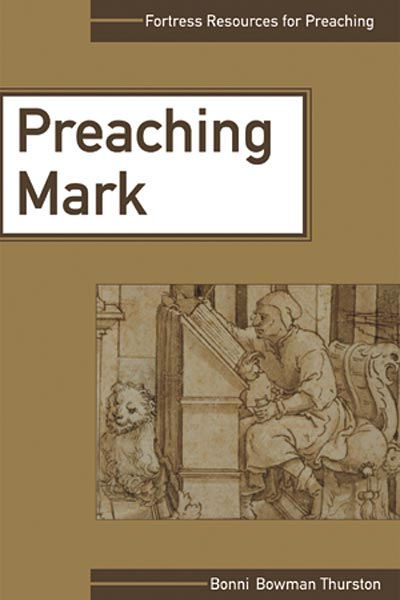Excerpts
Excerpt from the Preface
...This book was written specifically to aid preachers and teachers in the church. My particular focus is homiletical, although the homiletical suggestions may also serve as points for personal prayer and meditation. As such, the work differs in several ways from more traditional scholarly commentaries, not the least of which is that I abandon the ruse of scholarly omniscience and write in the first person as preacher to preacher, teacher to teacher.
First, I treat canonical Mark in English. That is, I deal with the Gospel as we have it in modern English translations. ... While there is no more important interpretive tool for preachers of the New Testament than reading the text in the original Greek, I know that many preachers either do not have Greek or have allowed their seminary Greek to become rusty. Thus, although it is impossible to deal carefully with the text without alluding to Greek, I avoid as much as possible technical matters of translation, and I transliterate Greek when I introduce it.
Second, this work focuses on units of material rather than proceeding verse by verse. The lectionaries of the church present Mark's Gospel to the worshipping church in small units technically called pericopae. ... Furthermore, in examining particulars in great detail, verse-by-verse exposition has a tendency to obscure the general significance of a passage. Pheme Perkins notes in her introduction to Mark in the New Interpreter's Bible that "most parishioners encounter the text . . . in isolated fragments," therefore "people find it difficult to attend to the larger structural features in each individual Gospel." In order to address this practical fact, and because I think Mark carefully arranged the material in his Gospel, I first introduce larger units of material in discussing the texts and then treat the smaller pericopae within them.
Third, I have tried to avoid scholarly apparatus. I transliterate Greek, avoid technical textual matters, and keep documentation at a minimum. In order for the book to be useful for students and seminarians, I provide suggestions for further reading, and Appendix 2 is an annotated bibliography of works I have found to be of special interest to those preaching and teaching Mark. My "suggestions for further reading" are not always the most recent publications. My criteria for selection was usefulness to the preacher and teacher, not what has been published most recently.
Fourth, my remarks on the text move toward application. My methodological assumption is that, of all the Jesus material available to him, Mark preserved this material for a reason. Mark recorded these selections of the tradition he received because they spoke to his community, the church for which he wrote the Gospel. Thus behind my commentary on any given pericope are these questions: Why did Mark preserve this story? Why was it important for his community? My sense is that the answers to these questions should direct the course for contemporary preaching. Although it is not a particularly avant-garde position, I understand the Gospel of Mark to be a historical document (not, one should note, history). The intent of its author and his circumstances set limits on how the text should be interpreted in our own day. Mark's intent in preserving a story circumscribes to some extent its appropriate interpretation.
Finally, in this book I am not proposing an overarching theory about Mark's Gospel. Nor do I write to take issue with the scholars and commentators who do develop synthetic readings of Mark. My aim is far more modest: it is to provide preachers and teachers of Mark's Gospel with information to help them appropriately interpret and proclaim it. ...
Excerpt from Chapter 1
The Prologue: Introduction
1:1-15
Most commentators note that, although it is not poetic like the Gospel of John, Mark's Gospel is similar to John's in that it also has a prologue. The length of Mark's prologue is debated. Three possibilities are suggested. First, some scholars suggest 1:1-8 is the prologue, making it essentially the title and the ministry of John the Baptist. Others think that 1:1-13, the ministry of the Baptist and the temptation of Jesus are the prologue. The third possibility is that the prologue includes vv. 1-15.
In this regard, I am a maximalist and read vv. 1-15 as Mark's prologue. My decision is based on what appears to me to be the structure of the passage. Verse 1 begins and v. 15 ends with reference to the "good news," thus creating an inclusion. Within these brackets, material about Jesus and John alternates (Jesus, v. 1; John vv. 2-8; Jesus vv. 9-11; John v. 14a; Jesus vv. 14b-15). Verses 14-15 are included as the summary of Jesus' teaching and preaching, to which Mark frequently alludes in the early scenes of the Gospel. When teaching is mentioned but not reported, we are to remember vv. 14 and 15 as its content. What Mark does at the outset is to provide all the hearer or reader needs to understand Jesus and the Gospel. We begin with information that no character in the story has. We are told that Jesus is the Christ and the Son of God, facts that characters in the narrative must discover as it unfolds.
Morna Hooker notes that the information at the outset of Mark 1 "is primarily christological." The John the Baptist material makes the connection between Israel's past and Jesus. The baptism introduces the Trinity and provides divine confirmation of the identity of Jesus given in v. 1. The temptation of Jesus depicts him as one who overcomes Satan. And finally, vv. 14-15 summarize the preaching of the all-powerful Christ. The identity of Jesus and the extent of his ministry are summarized in these fifteen verses.
For Further Reading
R. H. Lightfoot, "The First Chapter of Mark's Gospel," in The Gospel Message of St. Mark (Oxford: Oxford Univ. Press, 1962).
Frank Matera, "The Prologue as the Interpretive Key to Mark's Gospel," JSNT 34 (1988): 3–20.

